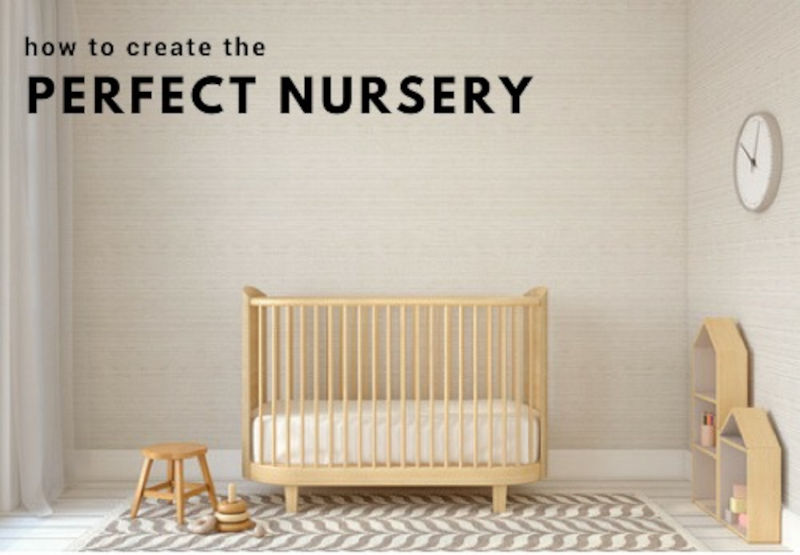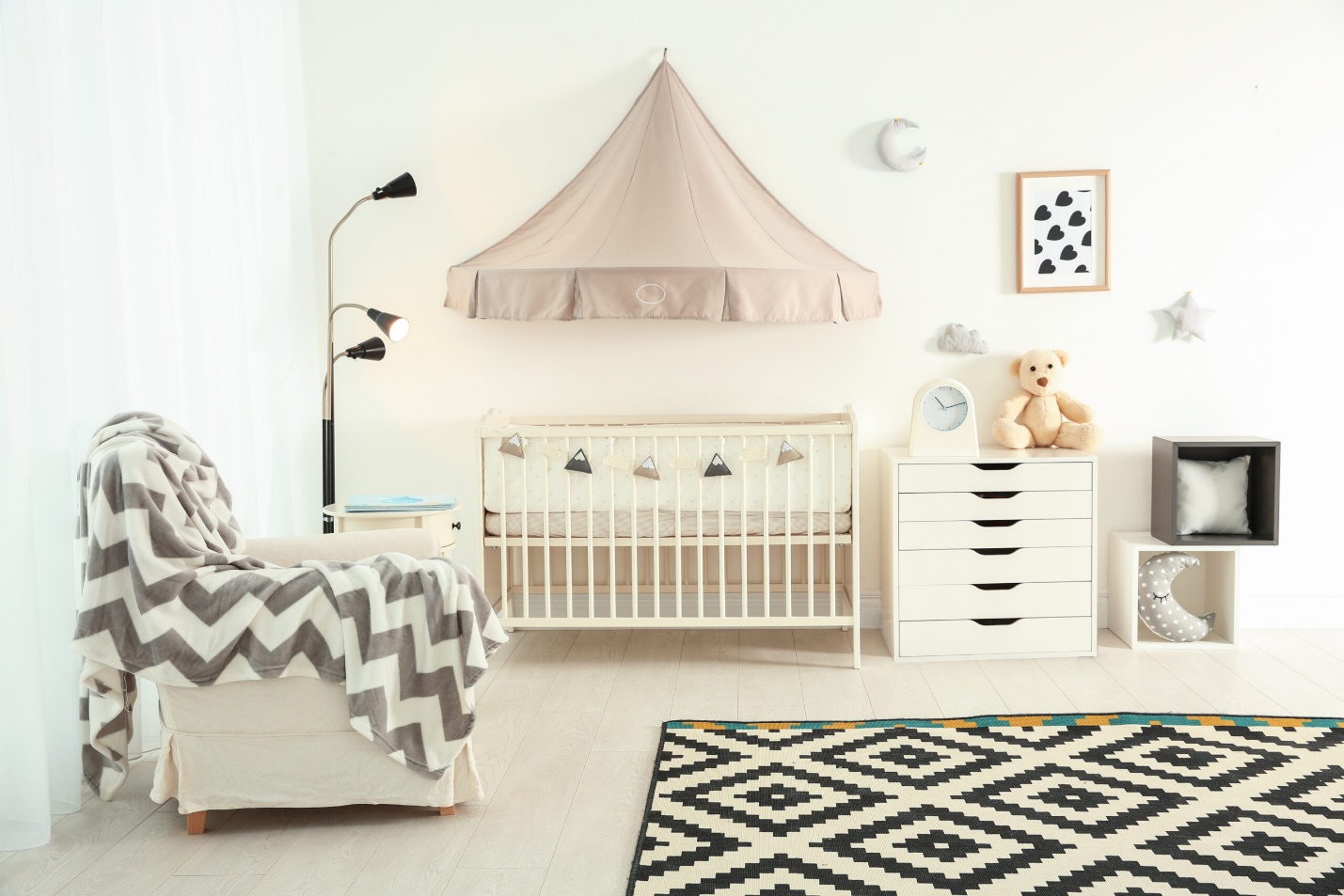
perfect baby nursery is a delightful and significant task for any new parent. It’s more than just a room—it’s a sanctuary where your little one will sleep, play, and grow. This space should be comfortable, functional, and safe, as well as reflect your style and provide a peaceful environment for your baby. Here are the top 10 tips for creating the perfect baby nursery:
1) Plan the Layout Thoughtfully
The first step in creating the perfect nursery is to plan the layout. The key is to balance aesthetics with functionality. Start by considering the main activities that will take place in the nursery: sleeping, diaper changes, feeding, and play. Organize the room so that each activity has its own dedicated space.
- The Crib Area: Place the crib in a quiet, low-traffic area of the room, away from windows or radiators, to avoid drafts and direct sunlight. This placement will create a cozy sleeping environment.
- The Changing Station: Position the changing table near the crib for easy access during nighttime diaper changes. Make sure you have storage nearby for diapers, wipes, creams, and extra clothes.
- The Feeding Nook: Create a comfortable seating area for feeding, ideally close to a nightlight or lamp, so you can see without waking the baby too much during nighttime feedings.
- Storage: Incorporate plenty of storage options, such as shelves, drawers, and baskets, to keep the nursery organized and clutter-free.
2) Choose a Soothing Color Palette
The color scheme of your nursery can significantly affect the mood and atmosphere. Soft, neutral tones like pastels, whites, and grays are popular choices because they create a calming environment conducive to sleep and relaxation. However, don’t be afraid to add a splash of color or incorporate your personal style.
- Neutral Base: Start with a neutral base for walls, furniture, and larger items. This will give the room a timeless look and make it easier to update as your child grows.
- Accent Colors: Add pops of color with accessories like curtains, rugs, artwork, and toys. Soft blues, pinks, yellows, or greens can add warmth and personality to the room.
- Textures and Patterns: Incorporate different textures and patterns to add visual interest. Think about using textured wallpaper, a patterned rug, or a variety of fabrics for cushions and throws.
3) Invest in Quality Furniture
The furniture you choose for the nursery will be used daily, so it’s important to invest in pieces that are both functional and durable. Safety should be your top priority, but comfort and style are also key considerations.
- The Crib: Choose a sturdy, well-constructed crib that meets all safety standards. Convertible cribs are a great investment because they can grow with your child, transforming into a toddler bed and even a daybed or full-size bed.
- The Changing Table: Look for a changing table with safety rails and ample storage. Some dressers come with a removable changing tray, allowing the piece to transition from a changing station to regular storage as your child grows.
- The Glider or Rocking Chair: A comfortable chair is essential for feeding and soothing your baby. Gliders or rocking chairs with padded armrests and a supportive back will make those long nights easier.
- Storage Solutions: Consider multifunctional furniture, like a crib with built-in drawers or a changing table that doubles as a dresser. These can save space and keep the room organized.d wallpaper, a patterned rug, or a variety of fabrics for cushions and throws.
4) Ensure Safety First
When designing a nursery, safety is paramount. Babies are curious and quick, so it’s essential to baby-proof the room before your little one arrives.
- Secure Furniture: Anchor all heavy furniture, such as dressers and bookshelves, to the wall to prevent tipping.
- Crib Safety: Make sure the crib mattress is firm and fits snugly within the crib, with no gaps. Avoid using pillows, blankets, or stuffed animals in the crib, as they can pose a suffocation risk.
- Electrical Safety: Cover electrical outlets with safety plugs and keep cords out of reach. Consider using cordless window treatments to avoid the risk of strangulation.
- Temperature Control: Use a room thermometer to monitor the temperature in the nursery. The ideal temperature for a baby’s room is between 68-72°F (20-22°C).
5) Incorporate Smart Storage Solutions
A well-organized nursery not only looks good but also makes day-to-day life much easier. Babies come with a lot of stuff—diapers, clothes, toys, blankets—so having a system to keep everything in its place is crucial.
- Closet Organization: If your nursery has a closet, make the most of it by adding shelves, bins, and hanging organizers. Dividers for clothes can help you sort by size or season.
- Drawer Dividers: Use dividers in dresser drawers to separate small items like socks, onesies, and bibs. This keeps everything easily accessible.
- Toy Storage: Baskets and bins are great for toy storage. Choose ones that are easy for little hands to reach and safe for babies to interact with.
- Vertical Space: Utilize wall space by installing shelves or wall-mounted organizers. These can hold books, toys, or decorative items without taking up floor space.

6) Create a Sleep-Friendly Environment
Creating a peaceful sleep environment is essential for your baby’s rest and overall well-being. Consider elements that will help your baby sleep soundly and comfortably.
- Blackout Curtains: Invest in blackout curtains or shades to block out light during naps and bedtime. This can help regulate your baby’s sleep patterns.
- White Noise Machine: A white noise machine can mimic the sounds of the womb, helping your baby sleep better by drowning out household noises.
- Temperature Control: As mentioned earlier, maintaining a comfortable room temperature is crucial. Consider a fan or heater if your home’s climate control isn’t consistent.
- Comfortable Bedding: Use soft, breathable crib sheets made from materials like cotton or bamboo. Avoid blankets and pillows; instead, use a sleep sack to keep your baby warm and safe.
7) Personalize the Space
Personal touches can make the nursery feel more special and unique. This is where you can let your creativity shine and add elements that reflect your family’s personality and style.
- Wall Art: Hang artwork, prints, or photographs that are meaningful to you. You could include family photos, custom name signs, or inspirational quotes.
- Themed Decor: If you have a specific theme in mind, such as animals, travel, or a favorite storybook, incorporate it into the room’s decor through wall decals, bedding, and accessories.
- Handmade Items: If you’re crafty, consider making something special for the nursery, like a knitted blanket, a mobile, or custom-painted furniture.
- Heirlooms: Include family heirlooms or keepsakes, such as a rocking chair passed down through generations or a quilt made by a relative. These items can add a sense of history and continuity to the room.
8) Focus on Lighting
Lighting plays a crucial role in setting the mood in a nursery. You’ll need different lighting options for various activities, from soft lighting for nighttime feedings to brighter light for playtime.
- Layered Lighting: Incorporate a mix of lighting sources, including overhead lights, lamps, and nightlights. This allows you to adjust the lighting based on the time of day and activity.
- Dimmable Lights: Consider installing a dimmer switch for the main light fixture. This way, you can lower the lights gradually at bedtime, helping your baby wind down.
- Nightlights: A soft nightlight can be comforting for both you and your baby during late-night feedings or diaper changes. Choose one with a warm, soft glow to avoid disrupting sleep.
- Natural Light: Maximize natural light during the day by keeping window treatments open. Natural light helps regulate your baby’s circadian rhythm and promotes better sleep at night.
9) Think About the Future
While it’s important to design a nursery that meets your baby’s needs, it’s also wise to think about the room’s long-term use. Consider how the space can evolve as your child grows.
- Convertible Furniture: As mentioned earlier, invest in convertible furniture like a crib that transforms into a toddler bed. This will save you money and effort down the road.
- Neutral Decor: By keeping the main elements of the room (walls, furniture) neutral, you can easily update the decor as your child’s tastes change.
- Storage Longevity: Choose storage solutions that can grow with your child. Adjustable shelving, modular storage units, and versatile bins can adapt to changing needs.
- Flexible Layout: Design the room with flexibility in mind. For example, a changing table that becomes a dresser or a play area that can later accommodate a desk for homework.
10) Prioritize Comfort for Both Baby and Parents
Finally, it’s important to create a nursery that’s comfortable for both your baby and you. You’ll be spending a lot of time in this room, especially in the early months, so consider your own comfort as well.
- Comfortable Seating: A glider or rocking chair with a cushioned seat and back support is essential for feeding and soothing your baby. Consider adding a footrest for extra comfort.
- Soft Rugs: A plush, soft rug can add warmth and comfort to the room. It’s also a great place for tummy time and playing with your baby.
- Easy Access: Keep essentials within arm’s reach of your seating area—whether it’s a side table with a lamp, a basket of burp cloths, or a water bottle for yourself. This will make those late-night sessions more comfortable.
- Relaxing Atmosphere: Incorporate elements that help you relax, like soothing colors, soft music, or


